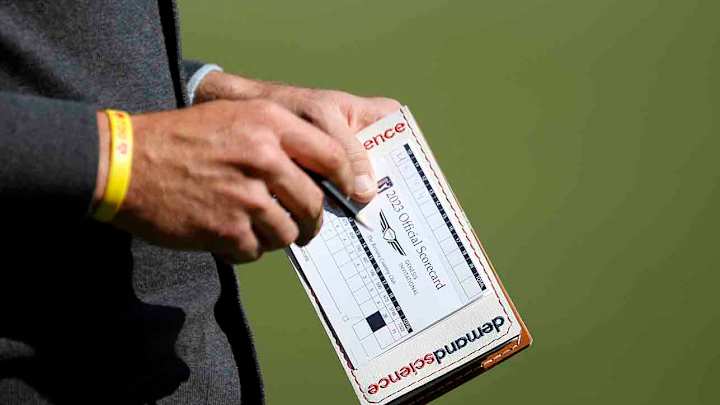An Altered Scorecard Rocked a Pro Event, but Why Are Scorecards Still a Thing?

When aspiring tour pro Justin Doeden admitted to falsifying his scorecard at a PGA Tour satellite event in Canada last month, the seismological effect on golf’s universe was significant, if only for a day or two. The incident gained traction because cheating is an intolerable sin in a game where honesty is the only policy. Because Doeden played collegiately at the University of Minnesota and is good enough to at least strive for a career at the sport’s highest level.
Because episodes like this are so rare they are newsworthy, which leaves inquiring minds wanting to know. Does it happen more often than we think? Does it occur at $20 million tournaments where the big boys gather? It’s one thing to steal an inch after you mark your ball on the green, another to erase that 7 you made on the 18th and replace it with a 5. Criminal acts are like wet dogs. They come in various shapes and sizes, but they all smell the same.
Why do scorecards still exist when first place pays $3.6 million, or $36,000, as was the case at the Commissionaires Ottawa Open? On my first trip to a bowling alley in like 25 years back in April, an electronic scoring system handled all the math, leaving us with nothing to do but roll the ball and drink beer. This added up to a highly enjoyable experience for about 45 minutes. Long enough to realize that if bowling can catch up to the 21st century, anything can.

It’s not that pro golf has a cheating problem or can’t justify its claim as the only athletic contest in which the competitors police themselves. It’s about adaptation—a progressive method of keeping score that eliminates mistakes and sends guys like Doeden out to look for a real job. In his case, changing a double bogey to a par so he could make the cut in Ottawa is the most egregious felony imaginable, especially on a developmental circuit where everyone stays at a Red Roof Inn and eats microwave popcorn for supper.
He lost his mind, and in all likelihood, Doeden lost his chance. Vijay Singh did the same thing in 1985 and was dealt a two-year suspension by the Asian Tour, a perceived injustice that provided a motivational spark to what became a World Golf Hall of Fame career, but he was bound to get there one way or another. Singh never confessed to the crime, never addressed the issue, period. Doeden acknowledged his wrongdoing on Twitter, leaving him with a clear conscience and a very murky future.
Other notable players have been suspected of impropriety over the years, but honesty often lurks in the shadows of subjectivity, and accusations can be as damaging as they are moot. Greg Norman hung Mark McCumber out to dry for an alleged green-tampering incident at Firestone Country Club during the 1995 World Series of Golf. Longtime CBS analyst Peter Kostis has stated publicly that he witnessed Patrick Reed break the rules on several occasions.
Aspersions were directed at Seve Ballesteros and Colin Montgomerie for behavior interpreted as an illegal advantage—both men were convicted in the eye of their fellow competitors on multiple occasions. Even Bernhard Langer, the ageless wonder whose durability might never have transpired without the broomstick putter, has survived through whispers among his brethren that he anchors the handle against his chest.
“Cheating and breaking the rules are two different things,” Ballesteros famously told Paul Azinger at the 1991 Ryder Cup. Fair point, although both forms of chicanery take you to the same courtroom and the same ornery judge. Golf is unforgiving to the point that it can cross the line between innocence and guilt as quickly as the act that warranted it. That brings the spirit of intent squarely into play, but at the same time, it suggests that what Doeden did with his pencil never would have happened in a fully modernized environment.
Yes, it’s a minor league comprised primarily of players who are never going to make it, but it still matters. The game holds itself in exceptionally high esteem, as if it must forever prove that it’s the cleanest sport known to mankind, so a cheater on some minitour leaves a smudge on the wall. If tournament directors at that level can find three people to hold up those "Quiet Please" signs on every tee box, they surely can find someone to walk with each group, track scoring on a hole-by-hole basis and transmit those numbers back to the clubhouse.
On the PGA Tour, there are standard-bearers, television folks, and the usual smattering of those who walk inside the ropes without anyone asking to see their credential. There are volunteers galore on every hole, and everybody watching on TV knows where any particular player stands as soon as his ball hits the bottom of the cup. All that information becomes accessible to the public almost immediately, thanks to the internet, completing a communicative process that can safely be described as errorless.
When asked if the Tour has ever considered the implementation of an automated scoring system, a knowledgeable source replied, “I’m sure they’ve looked at ways to make it better, but the tradition of the game is [still a factor]. There’s still a human component involved.” It’s a predictable response to a dated formality that very rarely shows us its dark side. A player finishes his round, trudges to the scoring trailer and makes his performance official by signing his scorecard, which was filled out by another player in the group.
It’s almost as archaic as the procedure requiring U.S. citizens to head to the nearest elementary school, pull the curtain shut behind them and vote for the politicians they consider the most qualified. We all know how well that’s been going lately.
